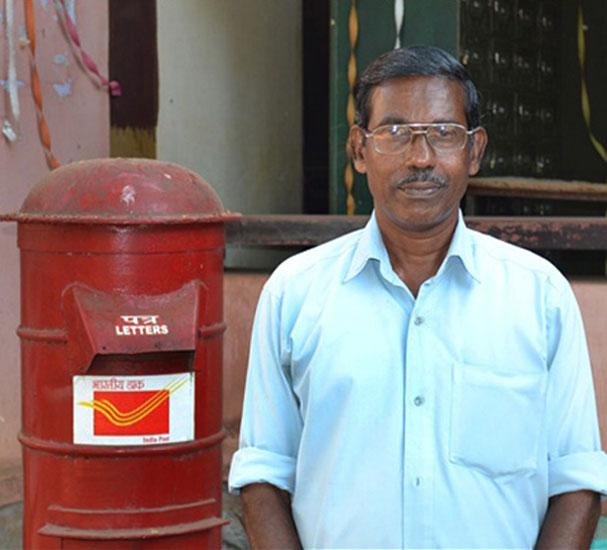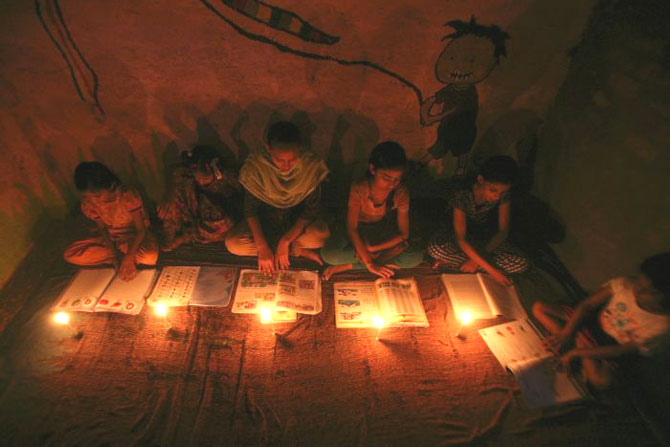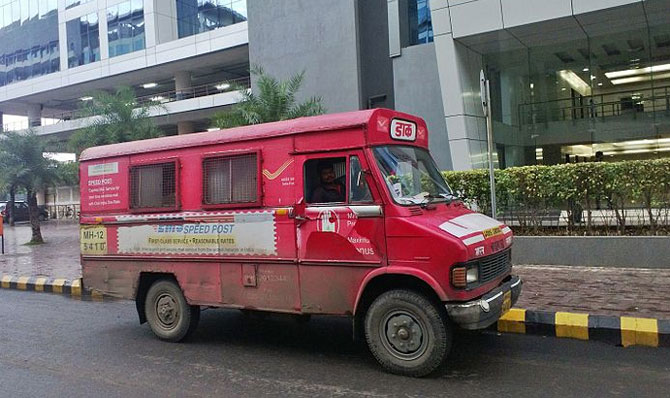Photographs: Manu A B/Rediff Manoj Kumar in New Delhi
Global investors may well be putting their faith in postmen like Phanin Deka when they decide to buy or sell Indian assets in the future.
He is one of about a thousand post workers collecting data that determines the level of India's consumer price index, which is likely to become the Reserve Bank of India's most important tool for setting monetary policy.
Deka, a postmaster in Sarpara in Assam, spends 6 days every month visiting two villages by bicycle to collect prices from 15 shops.
"At times, some shopkeepers refuse to co-operate. I think they consider me as an irritant, particularly when customers are around," said Deka.
Last week, a committee formed by Reserve Bank of India (RBI) Governor Raghuram Rajan proposed making CPI the central bank's main inflation measure and using it to set an inflation target, part of sweeping proposals to revamp monetary policy in a country that has long struggled with high inflation.
It would make CPI the most important data followed by the RBI and key in determining changes in interest rates that could affect millions of dollars in investments and loans.
Click on NEXT for more...
How postmen, and their wives, may help set India's monetary policy
Photographs: Danish Siddiqui/Reuters
For years, India has been an outlier among major economies by relying as its main inflation gauge on changes in wholesale prices, collected from India's cities. That was because the CPI was seen as too heavily geared to food prices, which are unresponsive to the ups and downs of interest rates because people have to eat.
There is a wide gap between wholesale and consumer inflation in India, so if the new set up is approved, economists expect higher interest rates for longer. In December, WPI inflation in Asia's third-largest economy was 6.16 per cent and CPI was nearly 10 per cent.
Using CPI as a benchmark eventually to bring inflation down to a targeted 4 per cent, plus or minus 2 per cent, would better reflect the way inflation affects the broader population, the committee argued.
However, the current CPI inflation series was launched only in 2012 and is based on nearly decade-old consumption patterns in a country of 1.25 billion people whose spending habits are changing fast. Average incomes have more than doubled over the same period.
It still measures changes in the cost of cassette tapes, while smartphones - fast becoming ubiquitous in India - are not included.
Click on NEXT for more...
How postmen, and their wives, may help set India's monetary policy
Photographs: Parivartan Sharma/Reuters
Power failures, worker strikes that shut shops and businesses, heavy rains and flooding, and even insurgencies all make the postal workers' data collection more difficult.
That leads to some guess work.
"Sometimes during the rainy season, I am unable to go out. Then I have no option but to fill in the prices of different items myself," said a postman in Guwahati, who declined to be identified.
"Usually I go to shops once or twice in two or three months to check price trends and fill in the price details myself by cross-checking with my wife," he said.
Arvind Mayaram, economic affairs secretary at the ministry of finance, acknowledged there are shortfalls in the consumer price index.
"CPI has a lot of imperfections," he told a TV channel last week. "We know that it requires a whole lot of sophistication, which we haven't achieved yet on determining CPI."
Click on NEXT for more...
How postmen, and their wives, may help set India's monetary policy
Photographs: Crack Pallingi/Reuters
Houses and milk
Consumption patterns between rural and urban India differ dramatically, and there is no data available on rural housing costs.
Food consumption, the key driver of persistent consumer price inflation, is changing as incomes grow, especially in rural areas. Indians now eat more protein, fresh fruits and vegetables, whereas in the past their diet was more based on cereals, rice and vegetables.
Statistics Ministry officials say the data is fairly robust and comparable to international standards, but needs to be updated to reflect changing consumption habits.
Food is now about 50 per cent of the index, the highest among the BRICS nations of Brazil, Russia, India, China and South Africa. That weighting will be brought down in a new CPI series, said T C A Anant, India's chief statistician. Clothing, now just under 5 per cent of the basket, would also change, he said.
"There has been a decline in the share of food in the total expenditure, and within food there is shift from cereals to protein, eggs, milk and other items that need to be reflected in the index," he told Reuters.
Food is a major source of inflation - about a third of fresh produce perishes before it reaches the shops - and is currently running at double digits.
Click on NEXT for more...
How postmen, and their wives, may help set India's monetary policy
Photographs: Anu Raj/Wikimedia Commons
Challenge
India's postal service started in 2011 to collect price data for the Statistics Department.
Collecting quality information on roughly 300 index items is a challenge in such a large country, and some officials privately expressed doubt over the quality of price data collected by the postmen in village markets.
"A postman who cannot even timely deliver letters, you expect him to gather price data on hundreds of items?" said a senior official at the statistics department. "You can imagine what happens when a truck driver drives a Mercedes-Benz car."
Large swathes of rural northeastern and central India are essentially controlled by militants in long-running ethnic and Naxalite insurgencies, one of the more extreme factors making it difficult to gather data.
"Half of the month here businesses remain shut due to strikes called by various organisations or there are other problems related to militancy," said another postman, who also declined to be identified.
Pronab Sen, head of the National Statistical Commission and Anant's predecessor as India's chief statistician, said that until the CPI index builds long-term data, the central bank should use both the CPI and WPI to set monetary policy.
"If two indices are telling me two different stories, and I ignore one, then what I am doing is essentially, deliberately losing information, and any loss of information leads to lower quality of decision," said Sen.
Additional reporting by Krishna N Das in New Delhi and Biswajyoti Das in Guwahati







article